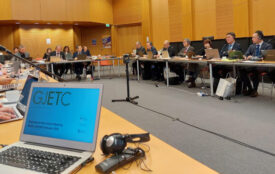Adoption of Latest IPCC Climate Science Sets World for Crucial Lima Talks, Underlines Urgent Need for Bold Political Agreement Post-2015
NEP Commends Extraordinary Efforts of Thousands of Scientists and Calls for Global Response Commensurate with the Scale of Challenges Ahead.
The Intergovernmental Panel on Climate Change (IPCC) will adopt and present, Sunday, a Synthesis of the Fifth Assessment Report (AR5) marking a pivotal moment in the fight against climate change, as consensus is reached on the latest authoritative science behind climate change impacts and risks and opportunities for response. This comes just weeks ahead of the UNFCCC climate talks in Lima, where negotiators will endeavor to broker an ambitious post-2015 climate agreement.
The report offers conclusive scientific evidence that human activities continue to cause unprecedented changes in the Earth’s climate with the conclusion that we need to elevate the level of political commitment and action, if we are to avoid the impacts of climate change.
UN Under-Secretary-General and UNEP Executive Director Achim Steiner said, “The latest IPCC report has provided us with not only with the latest climate science and data but also with a better understanding of the best options for action. The IPCC thus represents the foundation and a compass for the negotiations at Lima this December and Paris in 2015.”
“UNEP together with the IPCC and the scientific community recognize that knowledge gaps remain and that further research is needed. But the empirical evidence is not only sufficient to judge the risks of inaction; it is also compelling in terms of the many co-benefits of acting now to maintain a reasonable chance of limiting global warming to below 2°C,” he added.
Building on AR5 scenarios, UNEP’s soon-to-be launched 2014 Emissions Gap Report focuses on the global carbon emissions budget for staying within the 2°C limit while updating the near-term emissions gap situation. It will send another strong message on the need for urgent action and that every year counts.
Inaction now in curbing greenhouse gas emissions will require costlier interventions later to keep global temperature rise below 2°C this century. If the necessary action is not taken, adaptation costs for Africa alone could reach US$50 billion per year by 2050.
The proposed post-2015 Sustainable Development Goals underscore the multiple synergies between development goals and climate change mitigation.
For example, efforts to eradicate energy poverty and promote universal access to cleaner forms of energy, if fully realized, would, along with the goals for increased energy efficiency and utilization of renewable energy sources, go a long way toward bringing the world back on a path that is consistent with the Climate Convention’s 2°C target.
UNEP’s work on ecosystems-based adaptation shows that the response to climate change is not only a challenge and a cost, but is also an opportunity to move towards a more inclusive green economy in which measures deliver both immediate benefits in terms of reducing emissions and multiple benefits in improvements in public health, energy efficiency, food security and the ability to invest in mitigation measures while adapting to climate impacts and building long-term resilience.
Linking development with climate mitigation will help developing countries positively “lock-in” to an energy efficient, low-emissions infrastructure for the coming decades.
However, barriers need to be overcome before emissions reduction options achieve full potential, most notable among those is the lack of adequate, large-scale financial incentives.
There is evidence, nonetheless, that significant public and private investments are beginning to flow into energy efficiency; up to US$365 billion in 2012, with US$254 billion entering the renewable energy sector in the same year.
At the Secretary-General’s Climate Summit last month there was no shortage of goodwill and action from the finance sector.
The global financial sector pledged billions of dollars’ worth of voluntary action. More than 340 of the world’s top institutional investors, managing US$24 trillion, urged Heads of State to provide stable, reliable and economically meaningful carbon pricing that will help redirect investment as well as develop plans to phase out subsidies for fossil fuels.
Leading investors working with UNEP’s Finance Initiative pledged to reduce the carbon footprint of their investment portfolios for US$100 billion and to measure and disclose the carbon footprint of a total of half a trillion US$.
It is clear that public finance is pivotal to redirecting investment into a low-carbon future. It is also clear that capital markets, which control trillions of dollars, with the right incentives could be directed towards a green economy to close the funding gap for low-carbon energy and transport infrastructure, particularly in developing and emerging economies.
A new global climate agreement will need to be backed by innovative bottom-up action and supportive voluntary initiatives. UNEP is facilitating a number of initiatives with this aim.
The Climate and Clean Air Coalition to Reduce Short-Lived Climate Pollutants (CCAC) is the first global effort to treat short-lived climate pollutants as an urgent and collective challenge. It started with seven partners in 2012 and today it has 80. With its rapid growth, this global effort to reduce emissions of black carbon, methane and many hydrofluorocarbons has already touched numerous sectors of society in the effort to slow the rate of near-term global warming while protecting human health and the environment.
The Climate Technology Centre and Network (CTCN) represents another building block in a low-carbon future by accelerating the use of existing and new technologies that can improve the lives and livelihoods of millions of people in developing countries who are dealing with the impacts of climate change on a daily basis.
In the forestry-agriculture-climate change nexus, last year’s Warsaw Framework for REDD+ – backed by pledges of US$280 million – included a significant set of decisions on ways to help developing countries reduce greenhouse gas emissions from deforestation and the degradation of forests, which account for around one fifth of all human-generated emissions.
This year, at the Secretary-General’s Climate Summit, governments pledged to restore over 30 million hectares of degraded forest, and committed to more than double the 150 million hectare forest restoration target of the Bonn Challenge – which could add approximately US$85 billion to national and local economies and remove an additional one billion tonnes of carbon from the atmosphere each year.
Agriculture is another critical sector, as direct emissions are currently responsible for 11 per cent of global greenhouse gas emissions – even more if its indirect emissions are taken into account. UNEP’s International Resource Panel’s assessment of global land use shows that changes in land use and land cover due to the expansion of global cropland is accelerating climate change through the release of carbon dioxide, methane and other greenhouse gases including nitrous oxide.
However, this trend can be reversed through sustainable consumption and production actions such as adopting best management practices in agricultural production and implementation of policy instruments that address food waste and consumption.
The Synthesis Report of the Fifth Assessment Report builds on the reports of the three Working Groups of the International Panel on Climate Change (IPCC). It covers the following topics: Observed and future climate change, risks and impacts; Transformations and changes in systems; Adaptation and mitigation measures.
For more information on the launch of the Synthesis of the Fifth Assessment Report, visit: http://www.ipcc.ch
Further Resources








